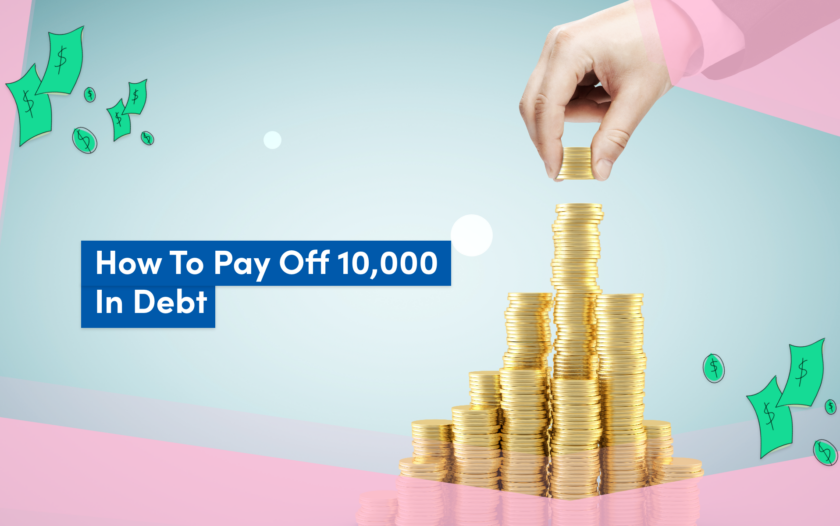5 Ways to Pay Off $10,000 Debt
About Caitlyn
Caitlyn is a freelance writer from the Cincinnati area with clients ranging from digital marketing agencies, insurance/finance companies, and healthcare organizations to travel and technology blogs. She loves reading, traveling, and camping—and hanging with her dogs Coco and Hamilton.
Read full bio
At a Glance
Dealing with a $10,000 debt may feel overwhelming, but with strategic planning and dedication, it’s entirely possible to overcome. Depending on your financial situation there are a variety of options to choose from. Read on to learn more.
Consolidate the debt
The first way you can pay off your debt is by consolidating:
1. Debt consolidation loan
One way to simplify your debt is through a debt consolidation loan. With a debt consolidation loan, you’re essentially combining multiple debts into a single, more manageable loan with, ideally, a lower interest rate. This approach streamlines payments, making it easier to track and manage your budget. Plus, you’ll save money in interest and may be able to pay off your debt faster.
Find and compare the best debt consolidation loan options.
Use the filters below to refine your search

Sorry, we didn’t find any options that meet your requirements. Please try modifying your preferences.
Congratulations! You’re close to seeing your offers!
Please take a second to review the details you shared earlier
Sorry, we didn’t find any options that meet your requirements. Please try modifying your preferences.
2. 0% APR credit card
Another consolidation avenue is a 0% APR credit card. This option allows you to transfer existing credit card debt balances to a new credit card without incurring interest for a specified period. Typically, these cards have a 0% intro APR period of 12-24 months, and during this time you won’t accrue interest on the balance. This way you’ll be able to focus on paying down the principal amount. However, make sure you pay off the balance (or at least make a big dent) before the intro APR period is up. Otherwise, you’ll start accruing interest at a much higher rate.
Read More: Best Credit Cards for Balance Transfers
Debt payoff strategy
Another option you can choose is a debt payoff strategy:
1. Debt snowball method
For those who prefer a psychological boost, the debt snowball method may be the right fit. This strategy involves paying off your smallest debts first, creating a sense of accomplishment and motivation to tackle larger balances. (Be sure to keep making the minimum payments on your other debts.) Once your smallest debt is paid off completely, move on to the next smallest, and so on until it’s paid off.
Learn More: Debt Snowball Method to Pay Off Debt
2. Debt avalanche method
The debt avalanche method prioritizes high-interest debts (again, while still maintaining minimum payments on your other debts). While this method may take longer, by focusing on the most expensive debts first, you minimize the overall interest paid in the long run.
Learn More: Everything You Need to Know About the Debt Avalanche Method
3. Pay more than the minimum
While you don’t technically have to, paying more than the minimum amount due can help you pay off your debt much faster. It ensures that a significant portion of your payment goes toward the principal rather than interest.
Debt relief
Debt relief can be another option for paying off $10,000 in debt:
1. Debts settlement service
Consider negotiating with creditors to settle your debt for a reduced amount. Debt settlement services can assist in navigating these negotiations, potentially helping you reduce the total debt owed. While this can help speed up the repayment process and decrease how much you owe, it could also have a poor impact on your credit score, you may accumulate late fees and interest charges during this time, and results aren’t guaranteed so you may end up owing as much (or more) as you did in the first place.
2. Debt management program
Enrolling in a debt management program involves working with a non-profit credit counseling agency to create a realistic repayment plan. Your counselor will contact your creditors to try to get them to lower your interest rates, waive late fees, and make your monthly payments more manageable.
Counselors can also help you create a budget, lower your expenses, and better manage your money. However, during this time you’ll lose access to your current credit cards and can’t open new lines of credit. Plus, results aren’t guaranteed.
3. Bankruptcy
While typically a last resort, bankruptcy might be necessary in severe cases. There are six types of bankruptcy, but the average person will file either Chapter 7 or Chapter 13. The benefits of bankruptcy include that you’re granted an automatic stay, you get relief from creditors, and your debts may be settled for less than what you owe or completely written off.
However, bankruptcy can do severe damage to your credit score and can be expensive and take a long time to complete. It’s essential to understand the long-term implications and explore alternatives before pursuing this option.
Find ways to increase your income
The more money you have coming in, the more you’ll be able to put toward paying off your debt. Increasing your income can help you pay off that $10,000 in debt faster. A few options include:
- Ask for more hours at your current job.
- Apply for a second job.
- Talk to your boss about a raise.
- Get a new job that has higher pay.
- Start a side hustle.
- Sell some of your stuff.
- Make money from your hobbies.
- Rent out a room in your house.
- Look for ways you can cut expenses.
Remember, extra income should be applied directly to your debt, accelerating the payoff process.
Make a plan for managing debt
If you manage your debt more responsibly, you may find ways to cut expenses and increase your savings, which can be used to pay off your debt.
1. Avoid unnecessary expenses
Take a close look at your budget, and identify and cut down on unnecessary expenses to free up more money for debt repayment. Consider things like:
- Canceling unnecessary subscriptions and streaming services.
- Canceling a gym membership.
- Eating at home instead of out.
- Avoiding the hair and nail salon.
- Only buying new clothes/shoes/etc. when you absolutely need them.
- Making gifts instead of buying them.
There are a lot of ways you can make small adjustments in your spending habits that can have a significant impact.
2. Credit counseling
Seeking professional advice through credit counseling can provide valuable insights into managing your debt effectively. A credit counselor can help you with a budget, develop a debt management plan, advise you on money, and even offer money management workshops.
Bottom line
Taking advantage of one or more of the above listed strategies (based on your financial situation and preferences) can help pave the way to financial freedom. While it may take time and discipline, a well-thought-out plan will help you regain control of your finances and pay off that $10,000 debt.
FAQs
The time it takes to pay off $10,000 in credit card debt can vary depending on the debt payoff method you use, but by only making minimum payments it can take as many as 28 years. Keep in mind the longer it takes to pay off your debt, the more you’ll owe in accrued interest, which can make it harder to pay it off completely.
Whether $10,000 in credit card debt is considered a significant amount depends on various factors, including your income, financial goals, and overall financial situation. However, it’s estimated that about 22% of American credit cardholders have balances of at least $10,000.
Minimum payments can vary – most card issuers use a flat percentage (typically 2-3%) of your statement balance. So with $10,000 in debt for example, you’d owe a minimum of $200 or $300.
While it seems like a lot, it’s possible to pay off $10,000 in credit card debt in one year. You can consolidate your debt with a debt consolidation loan or 0% APR credit card or try the debt snowball or debt avalanche method. Debt relief options include debt settlement services, debt management programs and bankruptcy. Or, find ways to increase your income and pay more than the minimum.









